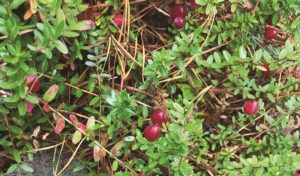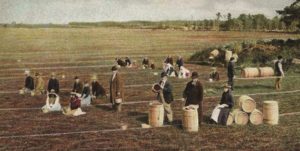Like a favorite fishing hole or blueberry patch, one’s preferred swath of wild cranberries becomes a closely held secret. Most folks will be adding a bag or two of commercially grown cranberries to their holiday shopping carts, but an intrepid few will descend into the wild bogs of the Seashore dunes to gather the tangy scarlet beauties whose name derives from the plant’s dainty springtime pink blossoms, which resemble the head and bill of a crane.
A native plant, the cranberry was widely used by Indigenous people in a calorie-rich food called pemmican, a mixture of tallow, dried meat, and berries that also served as a medicinal poultice to treat wounds and soreness and as a dye for clothing. Early settlers were introduced to the cranberry by Native people, and it became a staple on whaling voyages to prevent scurvy.
Commercial cranberry cultivation did not begin until 1816, when Henry Hall (1761-1850), a Revolutionary War veteran from a generations-old Dennis family, noticed that wild cranberries improved in size and quality when covered with a thin layer of blown sand. Hall experimented, creating new bogs in moist areas by transplanting vines and spreading sand, thus beginning the cranberry industry. As others copied Hall’s techniques, the town of Dennis became a center for cranberry cultivation until the mid-19th century, when other towns joined in. An 1854 agricultural census of Cape Cod noted that 197 acres of cranberry land were under cultivation in Barnstable County. Among those towns that caught the cranberry fever was Provincetown where 25 acres were farmed.

A pioneer of cranberry cultivation at Provincetown was Thomas Lothrop (also spelled Lathrop), a descendant of the Puritan minister John Lothrop (1584-1653) who had arrived in Scituate in 1634 and removed to Barnstable in 1639, where he was a founding father. His early meeting house is now part of Barnstable’s Sturgis Library.
Thomas Lothrop was born in Barnstable in 1800 to Ebenezer Lothrop Jr., a successful carpenter and captain of the militia during the War of 1812, and Temperance Lewis. Thomas went to Provincetown in the early 1820s — some accounts say to serve as the deputy collector — when the town, recovered from the deprivations of the Revolutionary War and the War of 1812, was beginning its ascendency as a prominent fishing and whaling port. Provincetown did not yet have a road through town, though all residents had a path running from their houses to the beach. By 1828, the enterprising Lothrop had built Provincetown’s first wharf extending from the path that is now Masonic Place as well as a public house — the Union House, later Fuller’s Hotel, and now the Atlantic House — that also accommodated the town’s courthouse. Once Front Street was laid out in 1835, Lothrop’s public house became the terminus for the stagecoach.
Always taking a lively interest in Provincetown’s public affairs, Lothrop served as justice of the peace and notary public and opened his home on Prince Street to civic meetings and July 4th celebrations. The same year that Lothrop built the Union House, he married Rebecca Cook (1806-1892), the daughter of David Newcomb Cook and Salome Lombard. Seven children were born to the Lothrops, two of whom became prominent doctors in Buffalo, N.Y.
In March 1847, the Barnstable Patriot reported that T. Lothrop Esq. was “transforming the wastelands near Shank Painter Pond into productive meadows, fertile gardens, orchards and cranberry grounds.” Lothrop was said to have endured “no little ridicule” and the “jibes and jeers of many of his neighbors.” His plan was thought sacrilegious — a working against Nature — and his cranberry patch was dubbed “Lothrop’s Folly.”

Certain that he would fail and convinced that cultivated cranberries would never thrive, townspeople left Lothrop to his folly and to the laborious work and considerable expense of filling in a large swampy area “up back” that was two to five feet deep. Enough beach sand was carried to the area to raise the swamp a few inches above the water, after which wild vines were set in the sand. Lothrop’s work also included preparing roadway access to the cranberries and anchoring the shifting sands around the swamp with beachgrass.
Despite difficulties and discouragement, Lothrop persevered, and by 1853 the Yarmouth Register was reporting that “Lothrop’s Folly” was now Lothrop’s cranberry patch, three acres reclaimed from barrenness and thickly covered with healthy vines, berries covering the ground, “a more charming sight you could not well imagine.” Though Lothrop never did convert the 70 acres that he originally had planned, his success spurred a great interest in cranberries, one newspaper reporting in 1856 that cranberry fever had bitten half of Provincetown. Among those making large investments and purchasing cranberry leases in the Province Lands were members of the extended Nickerson family who, having seen the success of Lothrop’s wharf, built the Union Wharf (current site of Sal’s Place) in 1831.
In April 1950, Cranberries: The National Cranberry Magazine wrote of Thomas Lothrop that he continued to cultivate Shank Painter Swamp until a month before his death on July 19, 1881 when “for the last time he hung upon a post of his four-poster bed a white kerchief it had always been his custom to wear about his neck in the old style. The image of a big, dignified man, with his white neckpiece, a pongee silk suit in summer, a white suit for Sundays and other ‘dress-up days,’ a man clean shaven and red cheeked, with white hair combed back from his forehead, has come down of this pioneer Provincetown grower whose vision The Patriot [of Barnstable] so enthusiastically painted as being of great value to the Cape and the state.”
After Lothrop’s death, his son, Ebenezer, maintained an interest in the bog. Later, townspeople took an interest, perhaps for sentimental reasons, but eventually the cultivated bogs were abandoned and reclaimed by nature.
